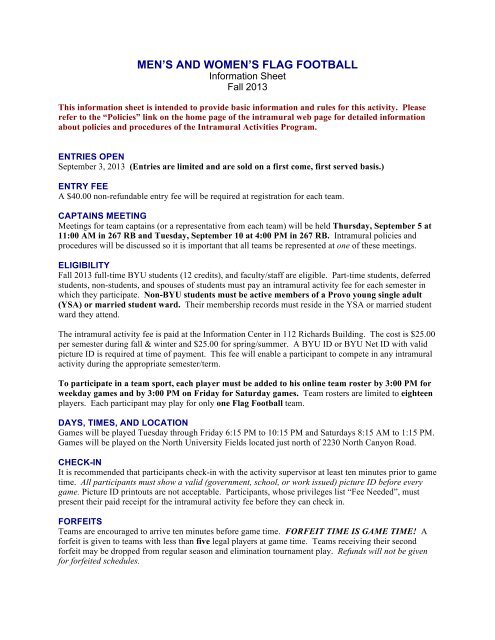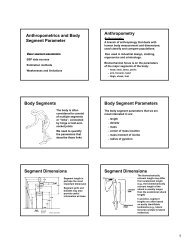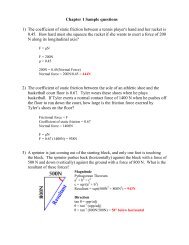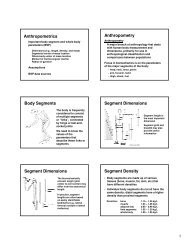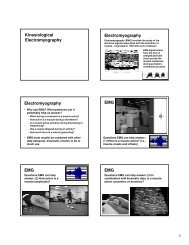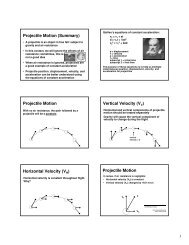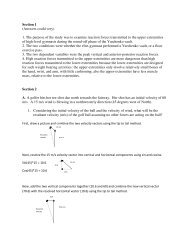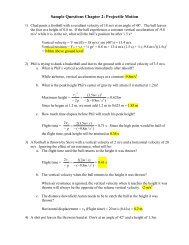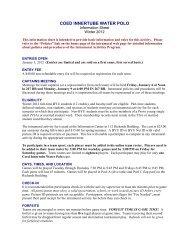men's and women's flag football - Brigham Young University
men's and women's flag football - Brigham Young University
men's and women's flag football - Brigham Young University
You also want an ePaper? Increase the reach of your titles
YUMPU automatically turns print PDFs into web optimized ePapers that Google loves.
MEN’S AND WOMEN’S FLAG FOOTBALLInformation SheetFall 2013This information sheet is intended to provide basic information <strong>and</strong> rules for this activity. Pleaserefer to the “Policies” link on the home page of the intramural web page for detailed informationabout policies <strong>and</strong> procedures of the Intramural Activities Program.ENTRIES OPENSeptember 3, 2013 (Entries are limited <strong>and</strong> are sold on a first come, first served basis.)ENTRY FEEA $40.00 non-refundable entry fee will be required at registration for each team.CAPTAINS MEETINGMeetings for team captains (or a representative from each team) will be held Thursday, September 5 at11:00 AM in 267 RB <strong>and</strong> Tuesday, September 10 at 4:00 PM in 267 RB. Intramural policies <strong>and</strong>procedures will be discussed so it is important that all teams be represented at one of these meetings.ELIGIBILITYFall 2013 full-time BYU students (12 credits), <strong>and</strong> faculty/staff are eligible. Part-time students, deferredstudents, non-students, <strong>and</strong> spouses of students must pay an intramural activity fee for each semester inwhich they participate. Non-BYU students must be active members of a Provo young single adult(YSA) or married student ward. Their membership records must reside in the YSA or married studentward they attend.The intramural activity fee is paid at the Information Center in 112 Richards Building. The cost is $25.00per semester during fall & winter <strong>and</strong> $25.00 for spring/summer. A BYU ID or BYU Net ID with validpicture ID is required at time of payment. This fee will enable a participant to compete in any intramuralactivity during the appropriate semester/term.To participate in a team sport, each player must be added to his online team roster by 3:00 PM forweekday games <strong>and</strong> by 3:00 PM on Friday for Saturday games. Team rosters are limited to eighteenplayers. Each participant may play for only one Flag Football team.DAYS, TIMES, AND LOCATIONGames will be played Tuesday through Friday 6:15 PM to 10:15 PM <strong>and</strong> Saturdays 8:15 AM to 1:15 PM.Games will be played on the North <strong>University</strong> Fields located just north of 2230 North Canyon Road.CHECK-INIt is recommended that participants check-in with the activity supervisor at least ten minutes prior to gametime. All participants must show a valid (government, school, or work issued) picture ID before everygame. Picture ID printouts are not acceptable. Participants, whose privileges list “Fee Needed”, mustpresent their paid receipt for the intramural activity fee before they can check in.FORFEITSTeams are encouraged to arrive ten minutes before game time. FORFEIT TIME IS GAME TIME! Aforfeit is given to teams with less than five legal players at game time. Teams receiving their secondforfeit may be dropped from regular season <strong>and</strong> elimination tournament play. Refunds will not be givenfor forfeited schedules.
EQUIPMENTThe participants must provide <strong>football</strong>s. The Office of Intramural Activities will provide <strong>flag</strong>s <strong>and</strong> fieldmarkers. The following equipment rules shall also apply:• The official ball must be pebble-grained leather or rubber covered <strong>and</strong> meet the recommendationsof size <strong>and</strong> shape for a regulation <strong>football</strong>. Men shall use the regular size <strong>football</strong> only. Theregular, intermediate, youth, or junior size <strong>football</strong> may be used for Women’s games.• A player wearing illegal equipment shall not be permitted to play. This applies to any equipmentwhich, in the opinion of the Supervisor or Referee, is dangerous or confusing. Types ofequipment or substances which shall always be declared illegal include:(a) Headwear containing any hard, unyielding, stiff material, including billed hats oritems containing exposed knots.(b) Jewelry.(c) Pads or braces worn above the waist. Casts worn above or below the waist.(d) Shoes with ceramic, screw-in, detachable cleats, or any projecting metal. Exception:Screw-in cleats are allowed if the screw is part of the cleat.(e) Shirts or jerseys which do not remain tucked in. Any hood on a coat, sweatshirt, orshirt which does not remain tucked in.(f) Pants or shorts with any belt(s), belt loop(s), or exposed drawstring(s).(g) Leg <strong>and</strong> knee braces, which are altered from the manufacturer’s original design.(h) Any slippery or sticky foreign substance on any equipment or exposed part of the body.(i) Exposed metal on clothes or person.(j) Towels attached at the player’s waist.UNIFORMSIt is recommended that each team have two sets of jerseys of differing colors. An appropriate,modest athletic uniform is permissible. Shirts <strong>and</strong> shoes must be worn. Sleeveless shirts are not allowed.Shirts/jerseys must be long enough to remain tucked in pants/shorts during the entire down. Teams mayelect to play in matching uniforms that conform to these st<strong>and</strong>ards. Players must wear athletic pants orshorts without any belt(s), belt loop(s), or exposed drawstrings. Pants or shorts without pockets arestrongly recommended. Jeans <strong>and</strong> other pants/shorts with pockets made of unyielding material willnot be allowed!OFFICIALSThe Office of Intramural Activities will provide all officials. Officials <strong>and</strong> supervisors assigned to yourgame have the authority to make decisions on any point not specifically covered by rules of the game orby intramural policies. Each team must designate a team captain to the Referee. Team representatives,including players, substitutes, spectators, <strong>and</strong> other persons affiliated with the team are subject to the rulesof the game <strong>and</strong> shall be governed by decisions of the supervisor(s) <strong>and</strong> officials assigned to the game.LIABILITYAll participants play at their own risk <strong>and</strong> must acquire their own insurance.INCLEMENT WEATHERThe decision to cancel activities due to inclement weather will be made by 4:00 PM on weekdays <strong>and</strong>8:00 AM on Saturdays. Participants may call the rainout hotline at 801-422-3992 for this decision.SPIRIT OF SPORTSMANSHIP“Athletics are explosive, as any of us know who have participated in them. The problem therefore, is todo everything that is fair <strong>and</strong> honorable to win, <strong>and</strong> also to know the line where sportsmanship stops <strong>and</strong>mockery starts. Stop short of winning if integrity is to be impaired…. Sportsmanship is the spirituality inathletics” (The Teachings of Ezra Taft Benson, 436-438).
Sportsmanship is everyone's responsibility. We hope everyone will conduct himself in a mature <strong>and</strong>friendly manner. Team captains are responsible for the conduct of their players <strong>and</strong> spectators. The BYUIntramural Activities program has identified the following principles as our “Spirit of Sportsmanship”guidelines. We encourage all employees, participants, <strong>and</strong> spectators to incorporate these principles on<strong>and</strong> off the playing field.1. Live with integrity: We believe in being honest, true, chaste, benevolent, virtuous, <strong>and</strong> in doinggood to all men… (Thirteenth Article of Faith). Be consistent with who you are in all situations.“We are what we repeatedly do; excellence, then, is not an act but a habit” (Aristotle).2. Be accountable: The gift of agency allows us the ability to choose right from wrong. Althoughwe are free to choose our actions, we are not free to choose the consequences. Other peoplecannot determine our feelings or thoughts. We are each accountable for the things we do <strong>and</strong> say<strong>and</strong> should never blame others for our behavior.3. Live the Golden Rule: And as ye would that men should do to you, do ye also to them likewise(Luke 6:31). “Good sportsmanship includes thoughtfulness <strong>and</strong> concern for others…humility invictory; <strong>and</strong> calmness <strong>and</strong> composure in defeat. It is fair play, following both the spirit <strong>and</strong> theletter of the rules. It is the Golden Rule in action on the playing court, on the bench, <strong>and</strong> in thest<strong>and</strong>s” (Physical Fitness, Sports, & Recreation Manual. The Church of Jesus Christ of LatterdaySaints, 1984; 17).4. Play by the rules: Do not push limits or escalate your level of physical play to match the style ofenforcement. Playing to the call or whistle instead of by the established rules of the game is aviolation of integrity <strong>and</strong> honesty. This style of play endangers the other players. Play hard, butplay fair <strong>and</strong> honor the rules.5. Turn the other cheek: If you begin to feel unsettled or agitated, take a personal timeout. Stepback to gain composure <strong>and</strong> perspective. Retaliation does not solve conflict—it only compoundsthe situation. Be meek. Ye have heard that it hath been said, An eye for an eye, <strong>and</strong> a tooth for atooth…whosoever shall smite thee on thy right cheek, turn to him the other also (Matthew 5: 38-39).6. Be gracious: Compliment your opponent after a good play. Focus on the good. Build peopleup—do not tear people down. Be genuine when you congratulate your opponent. Demonstrategratitude for the efforts of the officials <strong>and</strong> activity supervisors. A soft answer turneth awaywrath: but grievous words stir up anger (Proverbs 15:1).7. Have fun: …Men are, that they might have joy (2 Nephi 2:25). Be safe, play fair, <strong>and</strong> enjoy theexperience.YELLOW/RED CARD SYSTEMA yellow/red card system is used to monitor unsportsmanlike behavior <strong>and</strong> improper conduct. Aparticipant who receives a yellow card will be required to sit out for two minutes of game time. Aparticipant who receives a red card will be ejected from the game <strong>and</strong> must leave the field/court beforeplay resumes. A team with a carded player must play with one less player until the penalty time hasexpired (Yellow = 2 minutes & Red = 4 minutes).The following are examples of yellow/red card offenses:Yellow Card: Non-directional profanity; arguing; rough play; taunting opponents.Red Card: Illegal participation; directional profanity; <strong>flag</strong>rant contact; fighting; threatening behavior.
TOURNAMENT INFORMATIONThere will be one women’s division (open) <strong>and</strong> three men’s divisions (upper, middle, <strong>and</strong> lower) forregular season play. Each activity has a classification process that is intended to place similarly skilledteams against each other for tournament competition. Teams will be given a ranking between 1 <strong>and</strong> 5 (5being the highest) for each regular season game they play. To receive a 5 ranking, a team must beproficient in each of the following five criteria:1. Team has plays <strong>and</strong> can run them successfully.2. Passes are thrown with accuracy.3. Passes are caught with consistency.4. Defense successfully reads plays <strong>and</strong> pulls <strong>flag</strong>s.5. Team speed <strong>and</strong> athleticism.At the conclusion of regular season play an overall average of each team’s rankings will be computed <strong>and</strong>eligible teams will be placed in the tournament division that best fits their ability. Important tournamentdates are listed below.Wo<strong>men's</strong> Tournament Tournament classification rankings will be posted by 12:00 PM on Wednesday, October 30. Teams will have until 4:00 PM on Thursday, October 31 to challenge classification rankings. Tournament brackets will be posted by 4:00 PM Friday, November 1. Tournament play begins Tuesday, November 5.Men's Tournament Tournament classification rankings will be posted by 4:00 PM on Monday, October 28. Teams will have until 4:00 PM on Thursday, October 31 to challenge classification rankings. Tournament brackets will be posted by 5:00 PM Saturday, November 2. Tournament play begins Tuesday, November 5.RULESThe 2013-2014 NIRSA Flag & Touch Football rules will apply with the following points of emphasis<strong>and</strong>/or exceptions. This Rule sheet is only intended to provide the basic rules for intramural <strong>flag</strong> <strong>football</strong>.The Intramural Office (145 R.B.) has copies of the official NIRSA Flag & Touch Football rulebookavailable for check-out. You can also order a copy of this rule book by contacting the NIRSA nationaloffice by calling 541-766-8211 or order online: http://www.nirsa.org:1. Team Composition: Teams may consist of five (minimum) to seven (maximum) players on thefield. Team rosters are limited to eighteen participants.2. Game Duration: Each game will consist of two 20-minute halves with a two-minute breakbetween halves.3. Timing: The clock will stop for all time-outs <strong>and</strong> injuries. The clock will stop during the lastminute of the each half on incomplete passes, out of bounds, first downs, penalties, changes ofpossession, <strong>and</strong> scoring plays. However, if one team has a 10-point or more advantage during thesecond half, the clock will run regardless of the outcome of the play unless a time out is called.4. Timeouts: Each team will have 3 time-outs per game. Only one time-out is permitted in case ofovertime. No accumulation of time-outs is allowed.5. Coin Toss: The captain winning the coin toss shall have a choice of options for the first half orshall defer his/her option to the second half. The options for each half shall be:a. To choose whether his/her team will start on offense or defense.b. To choose the goal his/her team will defend.The captain not having the first choice of options for a half shall exercise the remaining option.
6. Penalty Provisions: The team captain’s first choice of any penalty option shall be irrevocable.Decisions involving penalties shall be made before any charged time out is granted to either team.7. Series of Downs: The team in possession of the ball shall have 4 consecutive downs to advanceto the next zone (first down line). A new series of downs shall be awarded when a team movesthe ball into the next zone on a play free from penalty, or a penalty against the opponent movesthe ball into the next zone, or an accepted penalty against the opponent involves an automatic firstdown.8. Punting: Prior to making the ball ready for play on fourth down, the Referee will ask theoffensive captain if he wants to punt. The offensive team may request to punt on any down.After such announcement, the ball must be punted. [Exception: If (a) a time-out is called byeither team, or (b) the period ends, or (c) a foul occurs anytime prior to or during this down thatresults in the kicking team having the right to repeat the down. The offensive team may thenchange their decision whether or not to punt the ball.] Neither K (kicking team) nor R (receivingteam) may advance beyond their respective line until the ball is punted. After receiving the snap,the kicker must immediately punt the ball in a continuous motion; any intentional delay to puntthe ball will result in a penalty. When a punt, which has crossed K’s scrimmage line, touches anyplayer from either team <strong>and</strong> then hits the ground, the ball is dead <strong>and</strong> belongs to R. However, if apunt hits R <strong>and</strong> is caught by K before the ball touches the ground, the ball is dead, belongs to K,<strong>and</strong> a new series begins for K. K may not kick to themselves.9. Snapping <strong>and</strong> Associated Restrictions: Following the ready for play <strong>and</strong> until the snap, no playeron defense may encroach, touch the ball, nor make contact with an opponent or in any other wayinterfere with them. This includes st<strong>and</strong>ing in the neutral zone to give defensive signals, orshifting through the zone. After the snapper has placed his h<strong>and</strong>(s) on the ball, it is encroachmentfor any player to break the scrimmage line plane, except for the snapper’s right to be over theball. The snapper, after assuming position for the snap <strong>and</strong> adjusting the ball, may neither movenor change the position of the ball in a manner simulating the beginning of a play until it issnapped. When over the ball, the snapper shall have his feet behind his scrimmage line. Thesnapper may snap the ball between his legs or to the side of his/her body. The offensive teammust have at least 4 players on their scrimmage line at the snap.10. H<strong>and</strong>ling the Snap <strong>and</strong> Associated Restrictions: The player who receives the snap must be atleast two yards behind the offensive scrimmage line. Any fumble of the snap will be declared adead ball <strong>and</strong> the ball will be downed at the spot it hit the ground.11. Motion: One offensive player may be in motion, but not in motion toward the opponent’s goalline at the snap.12. Passing: A forward pass is counted as a completion or interception as long as the first part of theperson to make contact with the ground after the catch, usually one foot, touches inbounds. Arunner may pass the ball backward or lose player possession by a fumble anytime. A backwardpass or fumble in flight may be caught or intercepted by any player inbounds <strong>and</strong> advanced. Allplayers are eligible to touch or catch a pass. An unlimited number of forward passes may bethrown <strong>and</strong> caught as long as they originate behind the line of scrimmage. It is illegal for apasser to catch his untouched forward pass. Any player may h<strong>and</strong> the ball forward or backwardat any time.13. Scoring Plays:a. Touchdown: A touchdown shall count as six points. The player scoring the touchdownmust raise his arms so the nearest official can de-<strong>flag</strong> the player. If the player is not de<strong>flag</strong>gedwith one pull <strong>and</strong> the official determines the <strong>flag</strong> belt has been secured illegally,the touchdown is disallowed, <strong>and</strong> the player is disqualified.
. Try: An opportunity to score 1 point from the 3 yard line, 2 points from the 10 yard line,or 3 points from the 20 yard line by running or passing shall be granted to the teamscoring a touchdown. It is the captain’s decision for which try will be attempted.c. Safety: A safety is worth 2 points during regular play, <strong>and</strong> 1 point during a try after atouchdown. After a safety, the ball shall be snapped by the scoring team at their own 14yard line, unless moved by penalty. A safety is when:i. A runner carries the ball from the field of play to or across his/her own goal line,<strong>and</strong> it becomes dead there in his/her team’s possession. [EXCEPTION:Momentum Rule—When a defensive player intercepts his/her opponent’sforward pass, fumble, backward pass, or a Team R player catches a punt betweenhis/her 5 yard line <strong>and</strong> the goal line <strong>and</strong> his/her original momentum carrieshim/her into the end zone where the ball is declared dead. The ball belongs to thedefensive team at the spot where possession was gained.]ii. A player punts, passes, fumbles, snaps, muffs, or bats a loose ball from the fieldof play to or across his/her goal line <strong>and</strong> the ball subsequently becomes deadthere in his/her possession.iii. A player on offense commits any foul for which the penalty is accepted <strong>and</strong>measurement is from a spot in his/her end zone; or throws an illegal forward passfrom his/her end zone <strong>and</strong> the penalty is declined in a situation which leaveshim/her in possession at the spot of the foul <strong>and</strong> with the ball having been forcedinto the end zone by the passing team.14. Offensive Screen Blocking: The offensive screen block shall take place without contact. Thescreen blocker shall have his h<strong>and</strong>s <strong>and</strong> arms at his side or behind his back. Any use of the h<strong>and</strong>s,arms, elbows, legs, or body to initiate contact during an offensive players' screen block is illegal.A blocker may use his h<strong>and</strong> or arm to break a fall or to retain his balance. A player must be onhis feet before, during, <strong>and</strong> after screen blocking. Teammates of a runner or passer may interferefor him by screen blocking, but shall not use interlocked interference by grasping or encirclingone another in any manner. Defensive players must go around the offensive player's screen block<strong>and</strong> may not initiate contact with his opponent if he is splitting two offensive screen blocks. Thearms <strong>and</strong> h<strong>and</strong>s may not be used as a wedge to contact the opponent. The application of this ruledepends entirely on the judgment of the official.15. Running with the Ball: The runner shall be prohibited from contacting an opponent withextended h<strong>and</strong> or arm. This includes the use of a "stiff arm" extended to ward off an opponentattempting to de-<strong>flag</strong>/tag. The runner shall not grasp a teammate or be grasped, pulled or pushedby a teammate. A runner shall not charge into nor contact an opponent in his path nor attempt torun between two opponents or between an opponent <strong>and</strong> a sideline, unless the space is enough toprovide a reasonable chance for him to go through without contact. If a runner in his progress hasestablished a straight-line path, he may not be crowded out of that path. But if an opponent isable to legally establish a defensive position in that path, the runner must avoid contact bychanging directions. The defensive player shall not hold, grasp, or obstruct the forward progressof a runner when in the act of removing the <strong>flag</strong> belt or making a legal tag.16. Flag Guarding: Runners shall not <strong>flag</strong> guard by using their h<strong>and</strong>s, arms, or the ball to deny theopportunity for an opponent to pull or remove the <strong>flag</strong> belt. Examples of <strong>flag</strong> guarding include,but are not limited to:a. Placing or swinging the h<strong>and</strong> or arm over the <strong>flag</strong> belt.b. Placing the ball in possession over the belt.c. Lowering the shoulders in such a manner, which places the arm over the <strong>flag</strong> belt.17. Flag Belt Removal: Players must have possession of the ball before they can be de-<strong>flag</strong>gedlegally. When a runner loses his <strong>flag</strong> belt either accidentally, inadvertently (not removed by
grabbing or pulling), or on purpose, play continues. The de-<strong>flag</strong>ging reverts to a one-h<strong>and</strong> tag ofthe runner between the shoulders <strong>and</strong> knees. In circumstances where a <strong>flag</strong> belt is removedillegally, play should continue with the option of the penalty or the play. A defensive playerintentionally pulling a <strong>flag</strong> belt from an offensive player without the ball is illegal. Tamperingwith the <strong>flag</strong> belt in any way to gain an advantage including tying, using foreign materials, orother such acts is illegal.18. Overtime: In the event of a tie game during regular season play, the game will st<strong>and</strong> as a tie <strong>and</strong>each team will be credited with a win. During tournament, a coin toss will ensue to begin thetiebreaker. The winner of the coin toss will be given the options of offense, defense, or direction,with all other options being exercised by the opposing captain. The offensive team will start 1 st<strong>and</strong> goal from their opponent’s 10-yard line <strong>and</strong> will have 4 downs to score a touchdown. If theysucceed in scoring, the offense will choose to go for a 1, 2, or 3 point try. Following the try ormissed conversion, the defense (now offense) will then attempt to score from the same 10-yardline <strong>and</strong> will be able to attempt a try if they score. If they win or fail to tie their opponent, thegame is over. If a tie still exists, another overtime is played until a winner is determined. If anydefensive team intercepts a pass <strong>and</strong> returns it for a touchdown, the game is over <strong>and</strong> they win.Summary of Fouls <strong>and</strong> PenaltiesLoss of 5 Yards1. Required Equipment Worn Illegally2. Delay of Game (Dead Ball)3. Substitution Rules Infractions4. Infraction of Punt Formation5. Encroachment (Dead Ball)6. False Start (Dead Ball)7. Illegal Snap (Dead Ball)8. Offensive Player Not Within 15 Yards of Ball9. Infraction of Scrimmage Formation10. Player Out-of-Bounds When Ball is Snapped11. Offensive Player Illegally in Motion12. Player Receiving Snap Within 2 Yards of Scrimmage Line13. Illegal Shift14. Intentionally Throwing Backward Pass or Fumble Out-of-Bounds to Conserve Time (Loss ofDown if by Team A)15. Illegal Forward Pass (Loss of Down if by Team A)16. Intentional Grounding (Loss of Down)17. Helping the RunnerLoss of 10 Yards1. Illegal Player Equipment2. Two or More Consecutive Encroachments During Same Interval Between Scrimmage Downs3. Offensive Pass Interference4. Defensive Pass Interference5. Illegally Secured Flag Belt on Touchdown (Loss of Down if by Offense) (Automatic First Downif by Defense)6. Unsportsmanlike Player Conduct7. Spiking, Kicking, or Throwing Ball During Dead Ball8. Personal Fouls: i.e. (Strip or attempt to strip the ball, Unnecessary Contact of Any Nature,Hurdling, Drive or Run into a player, Tackling the runner, etc.)9. Roughing the Passer (Automatic First Down)10. Illegal Offensive Screen Blocking
11. Defensive Use of H<strong>and</strong>s12. Illegal Flag Belt Removal13. Guarding the Flag Belt14. Stiff Arm15. Obstructing or Holding the Runner16. Batting a Loose Ball17. Illegal Kicking18. Illegal ParticipationDisqualification (Red Card) Associated With Certain 10 Yard Penalties:1. Flagrant Unsportsmanlike Conduct by Players, Substitutes or Others Subject to the Rules2. Intentionally Kicking at or Swinging an Arm, H<strong>and</strong> or Fist at any Opposing Player3. Flagrant Spiking, Kicking, Throwing Ball4. Intentionally Contacting an Official or Supervisor5. Flagrant Personal Fouls6. Tackling the Runner7. Intentional Tampering With Flag Belt-Offense (Loss of Down)8. Intentional Tampering With Flag Belt-Defense (Automatic First Down)If you have any questions contact Michael in 145 RB (801-422-7597) or access our web page.http://intramurals.byu.edu/ Have a fun season!


